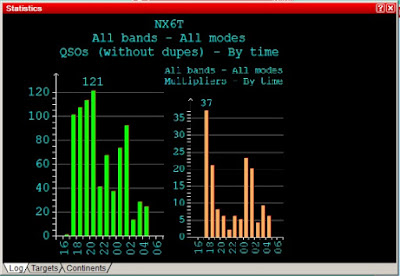- [x] - The CQ-160 Meter Contest - beginning @22:00z
- [x] -
The Malaysia DX Contest - beginning @ 00:00z - [x] - The BARTG RTTY Sprint Contest - beginning @ 12:00z
- [x] - The Winter Field Day (WFD) GiG - beginning @ 19:00z
Malaysia is a difficult country to make contact with from W7AYT's Concord QTH. Throughout
the weekend I heard no one operating this event, making it a no-show for WQ6X (explaining
the
With a limited bunch of operators for the 160 contest, making it all work was quite a challenge; especially when the IP-internet connection with the K3/0 coming and going. For the WQ6X operations a classic CH-250 was used for bands other than 160 meters, which was handled
by the WQ6X Lazy 8JK Inverted Vee.
While the 8JK antenna worked reasonably well, the extraneous RF floating around the radio room made the dimmer-lights blink and my Samsung cellphone screen go crazy. I guess it's
time to install a number of grounding straps sending that RF where it really belongs.
Time was also made for a number of equipment tweaks to the FT-1000mp, as well as audio-cable upgrades with Elecraft K3/0 and ICOM 7000. Running Stereo-Cw (by way of a pair of classic Autek QF-1A outboard filters) is a challenge unto itself. The RigExpert PLUS utilizes a custom-cable for
the FT-1000mp, intercepting the audio before it leaves the radio to the external filters. For a more pleasing RTTY experience, the mark/space tones were peaked by the QF-1A filters, sending each tone to a separate ear.
Amongst the various equipment adjustments, I found time to tension-adjust the main tuning knob
on the FT-1000mp, per the instructions detailed in the 1000mp's operating manual. Eventually,
the backlash experienced previously was reasonably smoothed out.
Saturday morning, preempting the BARTG and WFD events, I made a rather humorous power point presentation to the Amateur Radio Club of Alameda (ARCA) on the subject of The Role of Respect in Radiosport. ([CLICK HERE] to see the YouTube video done of this presentation.
This presentation was based on a WQ6X Contest Blog series written nearly 2 years ago, by the same title. The witch doctor (at left) was one of the BEEFs mentioned in Part 1 of the original BLOG series on this subject ([CLICK HERE] to read the original posts and find out what role the witch doctor played in all this.)
Back @W7AYT by noon, it was time to check out the Winter Field Day (WFD). For logging the event, I thought all that would be necessary to
log the contest would be to select the ARRL FD entry from the contest list. Unfortunately, the software did not recognize anything entered.
Searching the internet I discovered that N1MM+ has a UDC (User Defined Contest) file for WFD-RTTY which is supposed to work for Ssb and Cw
as well. Installing that contest gave me the same data entry problems. Eventually, to make it all work I simply setup a DX log which didn't care what data was entered into the entry fields.
After the contest weekend was over I sorted things out, at least enough
to submit a WFD score to the 3830 Scores website.
In the middle of it all was the BARTG RTTY Sprint contest. Unlike NA Sprint contests (which are
only 4 hours), what made this a sprint contest was the minimal exchange - only a serial # was sent; no 5NN, no name/state and no GRID locator. While only 23 contacts ended up in the WQ6X log,
it was a fun diversion on Saturday in between running the CQ 160 remotely for NX6T and locally
as WQ6X.
Typical for 24+ hour contests I took the 2 am to sunrise shift both nights, altho with the K3/0 not seeing the internet, for Sunday morning I was relegated to running the RCForb remote software. Luckily this was a CW contest, making it less of a problem, altho internet dropouts required a lot
of repeats on the exchange. While I didn't make a LoT of QSOs as WQ6X in the CQ-160 contest,
at least I had no internet dropouts to contend with.
On Sunday, the log ended with two DUPs: JE1BUJ and surprisingly, KH6LC. HuH? How did that happen Lou? Prior to that five JA stations and JT5DX made it to the log; an advantage of being on the West coast. Hours earlier, N6KI put multiple stations in zone 14, 15 & 33 into the log; not an easy thing to do from the Left coast.
Considering that our only antenna was a coaxial bazooka inverted Vee @ 70' atop a hill 900' in the air, we did amazingly well. It would seem that we were the top M/S team on the Left coast; not bad for 3 operators winging it remotely.
Did YOU work the CQ 160 meter contest?
Is NX6T (or WQ6X) in YOUR LoG?



































